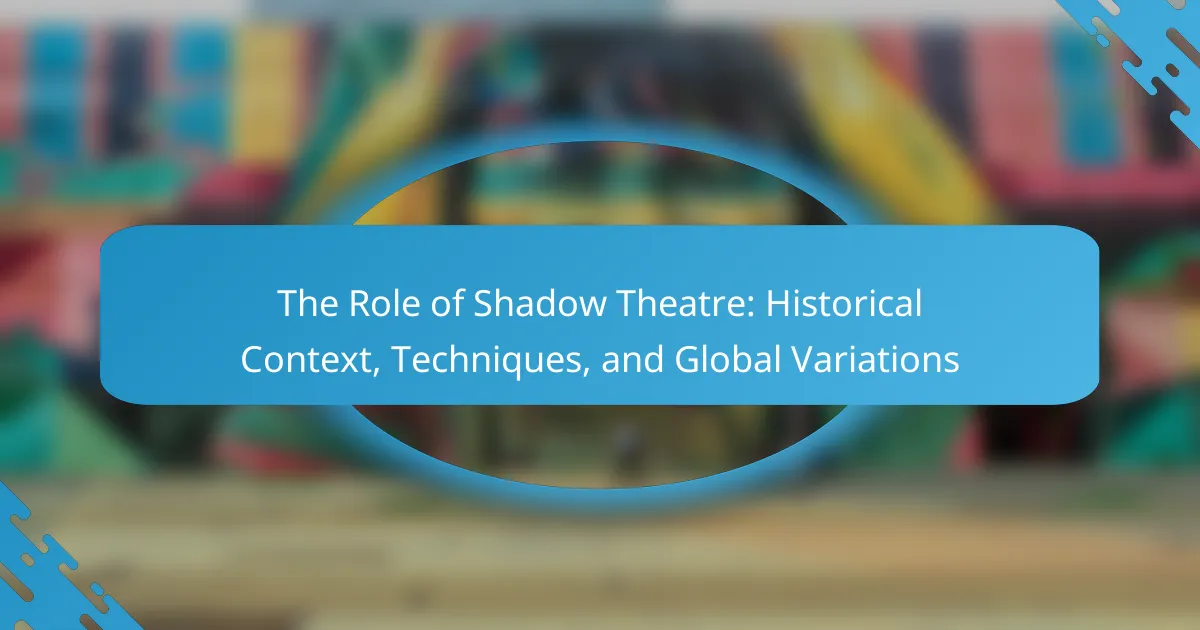Puppet theatre is a performance art that uses various types of puppets to tell stories and entertain audiences, with historical roots in ancient civilizations such as Greece, India, and China. This art form has evolved over time, encompassing diverse varieties like shadow puppetry, marionettes, hand puppets, and rod puppets, each with unique characteristics and cultural significance. Contemporary puppet theatre has integrated technology and innovative storytelling techniques, often addressing social issues and expanding its reach through digital platforms. The ongoing transformation of puppet theatre reflects its adaptability and relevance in the modern artistic landscape, supported by festivals and workshops that foster cross-cultural exchanges and new techniques.

What is Puppet Theatre and its Historical Significance?
Puppet theatre is a form of performance that uses puppets to convey stories and entertain audiences. It has roots in various cultures, dating back thousands of years. Historical evidence shows that puppet theatre was practiced in ancient civilizations like Greece, India, and China. In these cultures, it served both entertainment and educational purposes. Puppet performances often reflected societal values and folklore. The art form has evolved through the centuries, adapting to cultural changes. Its significance lies in its ability to engage audiences of all ages and convey complex themes through simple means. Today, puppet theatre continues to thrive, showcasing its historical importance and cultural relevance.
How did Puppet Theatre originate across different cultures?
Puppet theatre originated as a form of storytelling across various cultures. It can be traced back to ancient civilizations, including Egypt and Greece. In Egypt, puppetry was used in religious rituals and entertainment. Ancient Greek theatre incorporated puppets to enhance performances. In Asia, shadow puppetry emerged around the 2nd century BCE, particularly in Indonesia and China. These cultures utilized puppetry to convey moral lessons and entertain audiences. In Europe, marionettes became popular during the Renaissance, showcasing intricate craftsmanship. Each culture adapted puppetry to reflect its unique traditions and narratives. This rich history highlights the universal appeal of puppet theatre as a means of expression.
What are the earliest forms of Puppet Theatre recorded in history?
The earliest forms of Puppet Theatre recorded in history include shadow puppetry and rod puppetry. Shadow puppetry dates back to ancient China around the Han Dynasty (206 BCE – 220 CE). It involved the use of flat, articulated figures that were cast against a backlit screen. Rod puppetry has roots in ancient Greece, with evidence of its use in the 5th century BCE. These early forms were often used for storytelling and entertainment. Historical texts and artifacts support the existence of these puppet styles in various cultures.
How did cultural exchanges influence the development of Puppet Theatre?
Cultural exchanges significantly influenced the development of Puppet Theatre by facilitating the sharing of techniques and storytelling traditions. As different cultures interacted, they introduced unique puppet styles and performance methods. For example, the Italian commedia dell’arte influenced European puppet shows with its character archetypes and improvisational style. Similarly, Asian puppetry traditions, such as shadow puppetry from Indonesia, impacted Western puppet theatre by introducing intricate storytelling and visual artistry. Historical trade routes and colonization played crucial roles in these exchanges. They allowed for the migration of artists and the blending of cultural practices. This resulted in a rich tapestry of puppet theatre that reflects diverse influences and innovations.
Why is Puppet Theatre considered an important art form?
Puppet Theatre is considered an important art form due to its unique ability to convey complex narratives through visual storytelling. It engages audiences of all ages by combining performance, art, and craftsmanship. Historically, Puppet Theatre has roots in various cultures, serving as a medium for social commentary and cultural preservation. For example, traditional forms like Bunraku in Japan and Wayang Kulit in Indonesia have been used to reflect societal values and historical events. The tactile nature of puppetry allows for imaginative expression, making it accessible and relatable. Additionally, it fosters creativity and collaboration among artists, contributing to its significance in the performing arts landscape.
What social and educational roles has Puppet Theatre played historically?
Puppet theatre has historically served significant social and educational roles. It has been a medium for storytelling and cultural expression. Puppet shows often address social issues, reflecting community values and norms. They engage audiences in discussions about morality, justice, and human behavior. Educationally, puppet theatre has been used to teach children and adults alike. It simplifies complex concepts through visual storytelling. Historical records show that puppet theatre was utilized in schools and community gatherings. This method of teaching promotes engagement and retention of information. Thus, puppet theatre has been both a social commentary and an educational tool throughout history.
How has Puppet Theatre contributed to cultural storytelling traditions?
Puppet theatre has significantly contributed to cultural storytelling traditions by preserving and transmitting folklore and historical narratives. It serves as a medium for cultural expression across various societies. Puppet performances often reflect societal values, beliefs, and historical events. For instance, traditional puppetry in Indonesia, known as Wayang Kulit, conveys moral lessons and cultural stories through shadow puppets. This art form has been recognized by UNESCO as an Intangible Cultural Heritage. In Europe, marionette theatre has depicted local legends and fairy tales, enriching community identity. Puppet theatre engages audiences of all ages, fostering intergenerational storytelling. Its adaptability allows it to incorporate contemporary themes while honoring traditional narratives.

What are the Different Varieties of Puppet Theatre?
The different varieties of puppet theatre include shadow puppetry, marionettes, hand puppets, and rod puppets. Shadow puppetry involves flat figures cast against a light source. This form has roots in ancient Asia, especially in Indonesia and China. Marionettes are puppets controlled by strings from above. They offer intricate movements and are popular in European traditions. Hand puppets are operated by the puppeteer’s hand inside the puppet. This style is often used in children’s theatre. Rod puppets are manipulated with rods attached to their limbs. This technique allows for versatile performances. Each variety has unique characteristics and cultural significance.
What types of puppets are commonly used in Puppet Theatre?
The types of puppets commonly used in Puppet Theatre include marionettes, hand puppets, shadow puppets, and rod puppets. Marionettes are controlled by strings and can perform intricate movements. Hand puppets are manipulated by the puppeteer’s hand inside the puppet. Shadow puppets are flat figures cast against a translucent screen. Rod puppets are operated using rods for movement. Each type has distinct characteristics that contribute to the storytelling in Puppet Theatre.
How do hand puppets differ from marionettes in performance?
Hand puppets and marionettes differ significantly in performance techniques. Hand puppets are controlled directly by the puppeteer’s hands, allowing for more immediate and expressive movements. This direct manipulation results in a more intimate connection with the audience. In contrast, marionettes are suspended from strings and manipulated from above, which can create more complex and fluid movements. However, this method can also distance the puppeteer from the puppet, affecting the expressiveness. The performance style of hand puppets is often more animated and personal, while marionettes can achieve a more graceful and choreographed appearance. Historical examples show that hand puppetry often emphasizes storytelling and character interaction, whereas marionette performances may focus on visual spectacle and intricate choreography.
What unique characteristics define shadow puppetry?
Shadow puppetry is defined by the use of flat, articulated figures to create visual storytelling through light and shadow. These puppets are typically made from materials like leather or paper. They are manipulated behind a translucent screen, allowing light to cast their silhouettes. The performance often involves intricate movements and gestures to convey narratives. Shadow puppetry is characterized by its cultural significance in various traditions, such as Indonesian Wayang Kulit and Turkish Karagöz. It combines visual art with musical accompaniment, enhancing the storytelling experience. The art form also emphasizes the interplay of light and darkness, creating a unique aesthetic. Historical records indicate that shadow puppetry dates back to ancient civilizations, further solidifying its importance in cultural heritage.
What are the various styles of Puppet Theatre around the world?
Puppet theatre encompasses various styles worldwide. Each style reflects cultural traditions and storytelling methods. Notable styles include Japanese Bunraku, which uses large puppets operated by multiple puppeteers. Indian Kathakali features colorful costumes and elaborate [censured] makeup. In Italy, Commedia dell’arte incorporates improvisation with hand puppets. Shadow puppetry, found in Indonesia and Turkey, uses light and silhouettes to create stories. In the United States, marionette theatre blends traditional and modern techniques. Each style has unique attributes that contribute to the global tapestry of puppet theatre.
How do Eastern and Western Puppet Theatre styles compare?
Eastern and Western Puppet Theatre styles differ significantly in form, technique, and cultural context. Eastern styles often emphasize intricate storytelling and visual aesthetics, utilizing shadow puppetry and marionettes. For example, traditional Indonesian Wayang Kulit features detailed leather puppets and elaborate backdrops. In contrast, Western styles focus more on character-driven narratives and comedic elements, often seen in ventriloquism and hand puppetry. The European tradition, such as Punch and Judy, highlights slapstick humor and direct audience interaction. These differences reflect the cultural values and artistic traditions of their respective regions, showcasing unique methods of expression and performance.
What regional variations exist within the broader categories of Puppet Theatre?
Puppet theatre exhibits significant regional variations across the globe. In Asia, for example, Indonesia is known for its Wayang Kulit shadow puppetry. This form utilizes intricately carved leather puppets and is often accompanied by gamelan music. In Europe, Italy is famous for its Commedia dell’Arte, which features stock characters and improvisational performances. This tradition emphasizes physical comedy and elaborate costumes.
In India, traditional puppet theatre includes Kathputli, which uses string puppets to tell folk tales. The puppets are often brightly painted and represent local culture. In the Middle East, the Arabic shadow play, Khayal al-Zill, employs shadow puppets to narrate stories from classical literature. Each of these forms reflects the cultural context and storytelling traditions of its region.
These variations highlight the adaptability of puppet theatre to different artistic expressions and cultural narratives.

How has Puppet Theatre Transformed in Contemporary Practices?
Puppet theatre has transformed significantly in contemporary practices through the integration of technology and innovative storytelling. Modern puppet productions often utilize multimedia elements, such as projections and sound design, enhancing visual and auditory experiences. Traditional puppetry techniques are being blended with contemporary art forms, creating hybrid performances.
Collaborations with visual artists and filmmakers are increasingly common, expanding the narrative possibilities of puppet theatre. Many contemporary puppeteers focus on social issues, using puppetry as a medium for activism and education. The rise of digital platforms has also allowed puppet theatre to reach wider audiences through online performances.
Festivals and workshops dedicated to puppetry are promoting cross-cultural exchanges and new techniques. This evolution reflects a broader trend in the performing arts, where boundaries between genres are increasingly blurred. The transformation of puppet theatre showcases its adaptability and relevance in today’s artistic landscape.
What modern techniques are being used in Puppet Theatre today?
Modern techniques in Puppet Theatre today include digital puppetry, which utilizes technology to enhance performances. This technique often involves motion capture and animation software. Another technique is the integration of multimedia elements, such as projections and soundscapes, to create immersive experiences. Puppeteers now use advanced materials like 3D-printed puppets for intricate designs. Additionally, interactive puppetry engages audiences through real-time participation. These methods reflect a shift towards blending traditional puppetry with contemporary art forms. The use of these techniques has been documented in various productions worldwide, showcasing their effectiveness in modern storytelling.
How has technology influenced the production of Puppet Theatre?
Technology has significantly influenced the production of Puppet Theatre. Innovations such as digital puppetry and automation have enhanced performance quality. The use of projection mapping allows for dynamic backgrounds and visual effects. Sound design technology has improved audio quality and synchronization with puppetry. Online platforms have expanded audience reach through streaming performances. Furthermore, 3D printing has enabled the creation of intricate puppet designs. Virtual reality experiences have introduced immersive storytelling elements. These advancements have transformed traditional practices and broadened creative possibilities in Puppet Theatre.
What innovative storytelling methods are being explored in contemporary performances?
Contemporary performances are exploring immersive storytelling methods. These methods include audience participation, where viewers influence the narrative. Another approach is the use of technology, such as augmented reality and projections. This technology enhances visual storytelling and creates interactive experiences. Additionally, non-linear narratives allow for multiple perspectives within a single performance. This technique engages audiences by challenging traditional storytelling structures. Collaborative storytelling also emerges, involving multiple artists and disciplines. These innovative methods reflect a shift towards more engaging and participatory art forms.
How is Puppet Theatre engaging with current social issues?
Puppet Theatre engages with current social issues by addressing themes such as inequality, climate change, and mental health. Productions often reflect societal challenges and provoke discussions among audiences. For instance, many contemporary puppeteers create works that highlight marginalized voices. These performances can serve as a platform for social commentary and activism. Puppet Theatre has a history of adapting stories to reflect the zeitgeist. Recent festivals and events showcase works that tackle pressing global concerns. This engagement fosters awareness and encourages community dialogue.
In what ways are contemporary puppeteers addressing cultural and political themes?
Contemporary puppeteers address cultural and political themes through innovative storytelling and diverse narratives. They often incorporate current social issues into their performances. These puppeteers use puppetry as a medium for political satire and commentary. Many productions tackle themes such as immigration, climate change, and social justice.
For instance, shows like “The Lion King” have explored themes of identity and leadership. Puppeteers also engage with community stories, reflecting local cultural dynamics. Workshops and collaborations with marginalized groups enhance representation in puppetry. Festivals often feature works that challenge societal norms and provoke critical thinking.
This approach not only entertains but also educates audiences on pressing issues. By blending art with activism, contemporary puppeteers create impactful experiences that resonate with viewers.
How does Puppet Theatre serve as a platform for community engagement?
Puppet theatre serves as a platform for community engagement by fostering collaboration and participation among diverse groups. It allows local artists and community members to express cultural narratives. Workshops and performances often involve community input, making theatre a shared experience. Puppet theatre can address social issues, promoting dialogue and awareness within the community. Events often attract various demographics, enhancing social cohesion. By incorporating local stories, it strengthens community identity and pride. Research shows that participatory arts initiatives, like puppet theatre, can improve community well-being and connectivity.
What are the best practices for creating impactful Puppet Theatre performances?
To create impactful Puppet Theatre performances, focus on strong storytelling. Engaging narratives captivate audiences and enhance emotional connection. Develop well-defined characters that resonate with viewers. Use distinct voices and movements to bring these characters to life. Incorporate innovative puppetry techniques to create visual interest. Techniques can include shadow puppetry, marionettes, or hand puppets. Ensure the puppets are well-crafted, as quality materials influence performance perception. Integrate sound and music to enhance the atmosphere and support the narrative. Collaborate with skilled puppeteers to ensure seamless execution. Rehearsals are essential for timing and coordination, leading to a polished performance.
What key elements should be considered in scriptwriting for Puppet Theatre?
Key elements in scriptwriting for Puppet Theatre include character development, dialogue, and staging. Character development is crucial as it defines the personalities and motivations of the puppets. Dialogue must be engaging and suitable for the target audience, often incorporating humor or moral lessons. Staging involves considering how the puppets will move and interact, which affects the pacing and flow of the performance. Additionally, thematic coherence ensures that the story aligns with the intended message or moral. Finally, visual elements, such as puppet design and set aesthetics, play a significant role in enhancing the narrative. These elements collectively contribute to a compelling and effective Puppet Theatre script.
How can puppeteers effectively connect with their audience during performances?
Puppeteers can effectively connect with their audience by using engaging storytelling techniques. Storytelling captivates attention and fosters emotional connections. Incorporating humor and relatable themes enhances audience engagement. Utilizing dynamic puppetry movements keeps the performance visually interesting. Eye contact with the audience creates a personal connection. Interacting with audience members encourages participation and involvement. Research shows that emotional engagement increases audience retention and enjoyment. A study by the University of Edinburgh found that interactive performances significantly enhance audience satisfaction.
Puppet theatre is a performance art that utilizes puppets to tell stories, with historical significance tracing back to ancient civilizations such as Greece, India, and China. The article explores the origins, historical roles, and cultural exchanges that shaped puppet theatre, highlighting its educational and social functions. It also examines various styles and types of puppetry, including shadow puppetry and marionettes, while addressing contemporary practices that incorporate technology and innovative storytelling methods. Additionally, the article discusses how modern puppeteers engage with social issues and foster community participation through this versatile art form.



